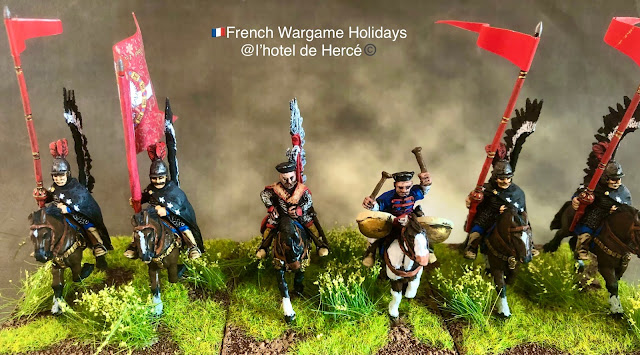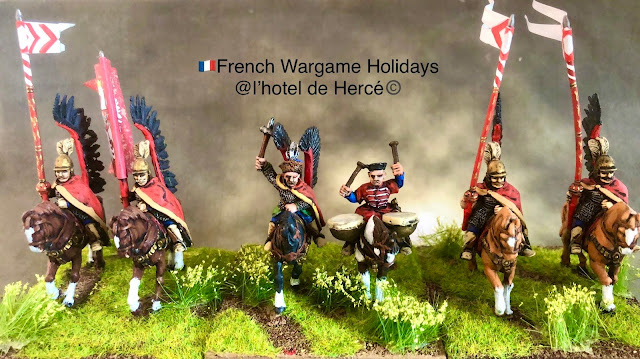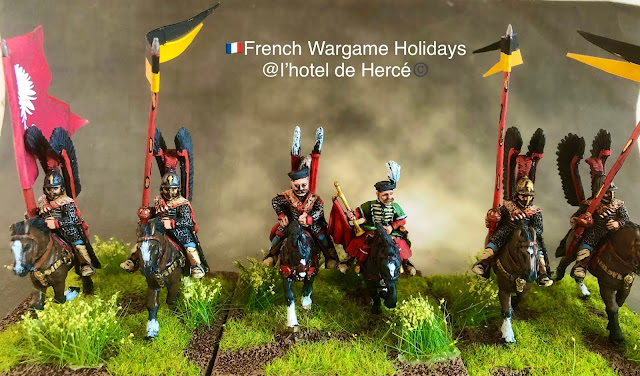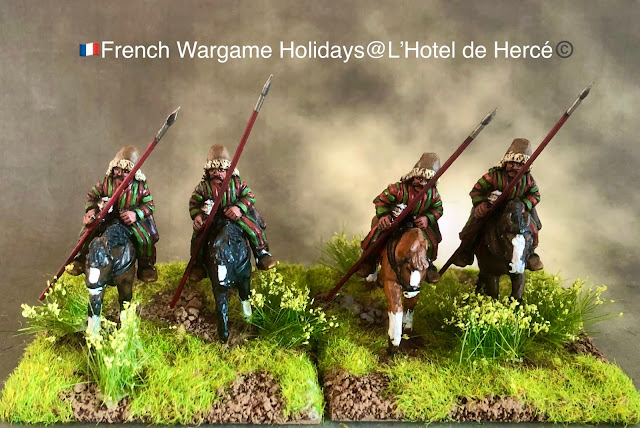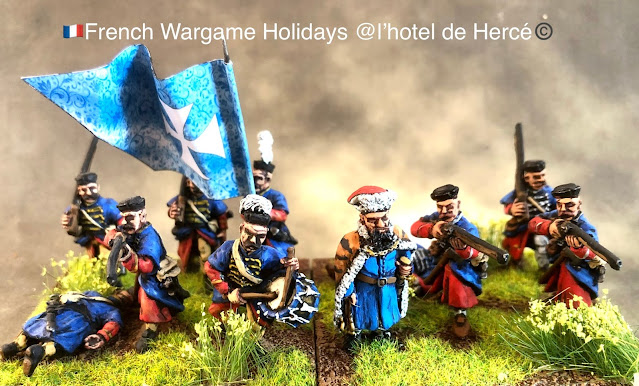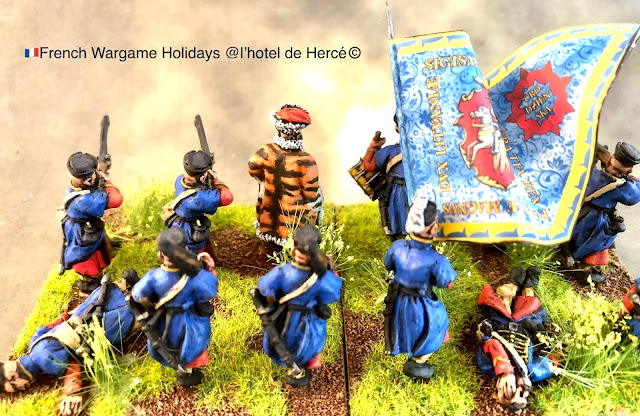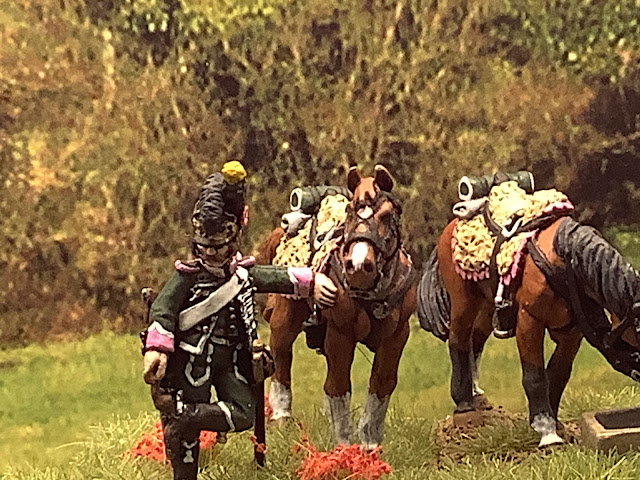Prussian Line infantry 1813-15
OrganisationUpon mobilisation in 1813 the line battalions were bought up the strength of 801 men and officers, the grenadier to 805 men and officers. The canton system was removed, universal conscription commenced and the Landwehr was raised.
The regiments went through a new renumbering when the guard grenadiers were removed from the first Regiment and a second regiment of foot guards were raised at the same time, this change causing a cascade of regiments being renumbered. A new regiment was also raised the Brandenburg numbered the 12th regiment.
Reorganisation occurred again in 1814 after the joining of annexing of confederation states regiments.
Two foot guard regiments
Two grenadier regiments, each of three battalions
32 line Regiments Pomeranian, West Prussian, Silesian, Brandenburg and former German states.
The first eleven regiments had two musketeer, one fusilier and two grenadier companies, from Régiment 12 onwards this was the theoretical structure with a number of regiments having up to four battalions some not having a designated fusilier battalion or grenadier companies.
Grenadier regiments
Regiments that troops were drawn from – 1813
1st Ostpreussisches Grenadier Bataillon (1 and 3 Regiment)
2nd Ostpreussisches Grenadier Bataillon (4 and 5th Regiment)
Pommersches Grenadier Bataillon (2 and 10th regiment)
Leib-Grenadier Bataillon (9)
Westpreussisches Grenadier Bataillon (6 and 7th Regiment)
Schlesisches Grenadier Bataillon (11 and 12th Regiment)
In October 1814 two Garde Grenadier Regiments were formed – “Kaiser Alexander” No 1 and “Kaiser Franz” No 2 - from the grenadier battalions.
Musketeer Uniform
The coat of Prussian infantryman was dark blue coat with lapels, collar, cuffs, in regimental colors as per the chart below. Turnbacks were red for all regiments.
Epaulettes were by seniority of the battalion in the regiment:-
First battalion white,
Second battalion poppy red
Third battalion yellow
Forth battalion light blue.
Breeches were mid-grey, tucked into black gaiters reaching to just below the knee. Boots were black, crossbelts were white for Musketeers, the lower one, worn over the right shoulder, carried the short sword, which had a brass hilt and black grip; the scabbard was black leather with brass fittings. Around the hilt was a sword knot which was used to distinguish the individual companies. The system is a complex one, but basically the companies were numbered consecutively, through the three battalions:
Sword Knots
Headgear
Musketeers wore a black shako with white top band, a black chinstrap, a black and white woolen pompom, cockade in the centre of the shako in 1813, normally on campaign the shako had a black oilskin cover. British and French shakos were also worn.
In 1814 a new shako was issued, black chevrons and no coloured trim on the top band, with an elliptical Pom Pom, brass chin scales attached by rosettes, a brass plate with the Royal monogram of FWR. White shako cords were worn on parade.
Regiments from 13 were not issued the new shakos until after 1815 but retained the cockade in the centre of the shako.
NCOs
Their insignia consisted of flat gold lace on the top edge of the cuffs and around collar. In 1813 the lace was moved from the lower edge of the collar to the top. NCOs also wore marching boots instead of gaiters and carried canes, attached to a tunic button. Black and white shako cords, Sword knots were white with embroidered black lines, for all companies.
Officers
gold band on shako, silver and black pompom, a gold Prussian eagle on each side of the shako over the chinstrap attachment with a double gold chain front and back, the sword had brass hilt and scabbard, around the waist was silver and black waist sash, white sword belt, brass buckles.
Fusilier uniform
The fusiliers had exactly the same uniform as the musketeers however they carried a short sword, black belts and had the cockade (a white circle) on the front of the shako cover.
Breeches wer mid-grey, tucked into black gaiters reaching to just below the knee. Boots were black, crossbelts were white for Musketeers and black for Fusiliers. the lower one, worn over the right shoulder, carried the short sword, which had a brass hilt and black grip; the scabbard was black leather with brass fittings. Around the hilt was a sword knot which was used to distinguish the individual companies. The system is a complex one, but basically the companies were numbered consecutively, through the three battalions:
Above the sword belt and over the left shoulder was the belt for the black cartridge box. This was plain for Fusiliers, but Musketeers had a brass oval plate bearing a trophy of arms.
The pouch was of brown calfskin and had a harness which matched the crossbelts in colour. All buckles were brass. The grey greatcoat was usually worn over the left shoulder, bandolier fashion, with a brown leather sleeve over the shoulder itself. A white linen haversack was worn on the left hip -- the strap was white. The mess tin, in a white cover, was usually attached to the pack.
The knee length greatcoat was grey, single breasted with six brass buttons. Collar and shoulder straps matched those on the kollet. The forage cap or feldmutz was often worn in this order o fdress. The first model was grey, similar to the World War One German forage cap -- it had a narrow band in provincial colour. In 1814, it was replaced by a grey peakless cap with a wide band in province colour and similar piping around the top.
The musket was always carried with the bayonet fixed, the stock was stained black for Fusiliers and brown for Musketeers. Fittings were brass and the sling was red.
In 1813, due to financial difficulties of the Prussian State there was little uniformity in the Prussian army. The Prussians wore their own uniforms, uniforms supplied by Britain, Russia and the defecting German state armies plus captured French uniforms.
In 1813 the infantryman carried a light brown or black knapsack and grey, white or natural linen bread bag. The grey greatcoat was worn rolled en bandolier over the shoulder also in summer. The canteen was strapped to the outside of the knapsack and sometimes was in a natural linen waxed or black linen bag. A piece of brown or black leather was wrapped around the greatcoat roll and buttoned to help keep it from working loose and slipping off the shoulder.
On parade the greatcoat was worn rolled and strapped on top of the pack. Its collar was in provincial color until October 18th 1813, after that was grey with provincial-colored rectangle patches on the front of the collar. The greatcoat was almost ankle-length but in 1814 it was shortened to mid calf length.
For the 1815 campaign a majority of the new regiments that were formed from reserve, foreign, and volunteer troops had not received their new uniforms of line infantry before the campaign began. Regiments' appearances were not unified, some individuals wore altered French uniforms, while others wore red coats and shakos from England. Their knapsacks were mix of Prussian, Swedish, British and French ones. Some wore even blue trousers or civilian ones.
During the Waterloo Campaign in 1815 some units had white uniforms. Peter Hofschroer explains the loss of many officers of the 28th Regiment (the former Berg regiment) at Gilly "because their Prussian blue uniforms contrasted with the white of their men, making them stand out as targets for French fire. The next day, the survivors were ordered to don their darker greatcoats so this would not happen again." (Hofschroer - "1815: The Waterloo Campaign ..." p 185)
Regiment Uniform Facings
1st Regiment (1st Ostpreussisches) East Prussia Orange Collar and Cuffs
2nd Regiment (1st Pommersches) Pomerania White Collar and Cuffs
3rd Regiment (2nd Ostpreussisches) East Prussia Orange Collar and Cuffs
4th Regiment (3rd Ostpreussisches) East Prussia Orange Collar and Cuffs
5th Regiment (4th Ostpreussisches) East Prussia Orange Collar and Cuffs
6th Regiment (1st Westpreussisches) West Prussia Carmine Collar and Cuffs
7th Regiment (2nd Westpreussisches) West Prussia Carmine Collar and Cuffs
8th Leib-Infantrie Regiment Poppy Red Collar and Cuffs
9th Regiment Colberg White Collar and Cuffs
10th Regiment (1st Schlesisches) Salesian Yellow Collar and Cuffs
11th Regiment (2nd Schlesisches) Salesian Yellow Collar and Cuffs
12th Regiment Brandenburgisches Poppy Red Collar and Cuffs, three battalions of Musketeers I Battalion July 1813, this was the I Reserve Battalion, Leib Infantry Regiment. Officers and cadre wore the regulation uniform of that Regiment, poppy-red facings, and white shoulder straps. shako in a cover, or grey cap witha poppy-red band. (Some men were still wearing caps in June 1815.) Black single breasted reservists jackets with poppy-red collar patches. No tails or shoulder straps were worn. Buttons were of white metal, though some sources state these were covered in the same material as the jacket. The majority of privates wore white trousers, outside grey gaiters, (black or grey breeches are also recorded). A cartridge box on a black belt, regulation pack with white straps, white haversack on the left hip and grey greatcoat over the left shoulder. II Battalion Before July 1813, this was the II Reserve Battalion of the Leib Infantry Regiment. The officers, the cadre and 517 men wore the regulation uniform of that unit. The remainder either wore the uniform of the I Battalion or a blue kollet of the regulation pattern, with a blue collar, poppy-red collar patches and white shoulder straps. The rest of the uniform and the equipment was as for the I Battalion, but short swords were also worn. These had white belts. Fusilier Battalion Before July 1813, this was the III Musketeer Battalion, First West Prussian Regiment. The officers and cadre wore the regulation uniform for that Regiment, with crimson facings and white shoulder straps. Privates wore either a grey cap with a crimson band or a regulation shako in a cover. The grey Reservists jacket had crimson collar patches, the buttons were covered in grey material and there were no shoulder straps. Grey breeches and black gaiters were worn. Equipment consisted of a cartridge box on black belt, grey cloth pack and haversack, both with white straps, and grey greatcoat. After the linking of these three Battalions, the distinctions of the Second Brandenburg Infantry Regiment (poppy-red facings and shoulder straps) were adopted by all ranks who wore the regulation uniform. The men of the II Battalion issued with the kollet with collar patches changed their shoulder straps to poppy-red, and the Fusilier Battalion changed their crimson collar patches to conform with the rest of the Regiment.
13th Regiment (1st Reserve Regiment) Yellow Collar and Cuffs, four battalions, Until July 1813, this was the III Musketeer Battalion, First East Prussian Infantry Regiment. Officers and cadre wore the regulation uniform with brick-red facings and white shoulder straps, while the privates wore grey caps with an orange-red band bearing red No.1, grey tailless jackets with white shoulder straps and grey trousers or breeches with black gaiters. Equipment consisted of a cartridge box on a white belt. After July 1813, the Battalion's appearance was radically changed when the 'British' uniform was issued. The shako was a Belgic model, with a white and red cockade, white over red plume and a brass oval badge with a lion rampant. They wore a dark blue 'British' jacket with white turnbacks bearing blue grenades, a red collar, round cuffs and shoulder straps, all piped white. Eight yellow metal buttons were worn on the front of the jacket, evenly spaced, and two on each cuff, with bars of white square ended lace. Dark blue or white trousers were worn tucked into gaiters, a white belt for the cartridge box and a regulation pack with white straps. Brown Bess muskets were issued to this Battalion, NCOs of this Battalion carried short swords on white belts and wore crimson wiast sashes. Musicians wore bars of white lace on their sleeves like their British counterpart. II and IV Battalion These Battalions, formerly the 1st and 2nd East Prussian Reserve Musketeer Battalions, adopted the regulation uniform of the First East Prussian Regiment. III Battalion All ranks dressed as the II and IV Battalions but with black leather belts instead of white. Before July 1813, this was the 1st Lithuanian Reserve Fusilier Battalion.
14th Regiment (2nd Reserve Regiment) White Collar and Cuffs, three battalions no fusiliers and was dressed in grey caps and tunics until July 1813. From July 1813 the 1st Bn wore a dark blue jacket, and an english style stovepipe shako and white crossbelts. 2nd bn were dressed in an English uniforms similar to that issued to the 1bn/1st RIR being a blue english style jacket, and english stovepipe shako. 3rd bn in a Dark blue jacket, dark blue trousers and white crossbelts, possibly with a French style shako. The 1st and 3rd bn's wearing red grenadier plumes whilst the 2nd wore yellow and green voltiguer plumes. All shako's were replaced with the Prussian model before the 1815 campaign.
15th Regiment (3rd Reserve Regiment) Yellow Collar and Cuffs, three battalions no fusiliers. Before July 1813, the men of all four Battalions wore the all-grey Reservists' uniform, described in the notes on the Second Reserve Regiment. The officers and cadre wore the regulation uniform of the Second East Prussian Regiment and this uniform, with its brick-red facings and poppy-red shoulder straps, was adopted by all Battalions. Cross belts were white for the I and II Battalions, black for the III. In 1815, the entire Regiment was recorded as wearing yellow shoulder straps.
16th Regiment (4th Reserve Regiment) Carmine Collar and Cuffs, three battalions no fusiliers. Before the armistice of June 4 1813, the officers and cadre seconded from the Third East Prussian Regiment wore that Regiment's uniform (brick-red facings and yellow shoulder straps). The men wore the all-grey Reservist dress with breeches and gaiters described above, the cartridge boxes and the grey cloth packs had white straps. Individual companies were distinguished by a cloth roundel on the cap band and a matching bar across the grey shoulder straps, coloured white, red, yellow and ligth blue for the 1st to 4th companies respectively. In addition, the I Battalion carried French sabre-briquets captured at Halle in April 1813. During and after the armistice, the following uniforms were worn. I Battalion French shako with badge and cockade removed. Dark blue habit-veste, single breasted with short tails, red collar and turnbacks, the latter with white grenades. Round red cuffs with two buttons each with two white square ended lace loops. White metal buttons, white trousers, possibly French and black gaiters. II Battalion Conical shako as for I/1 R.I.R. 'British' jacket, identical to that worn by the I/1 R.I.R., but with pointed lace. Blue trousers worn outside the gaiters. Regulation pack with white straps, grey British greatcoat. NCOs wore short swords on white belts, yellow lace on collars and cuffs and yellow waist sashes. III Battalion As for II Battalion with the following differences: black belts and straps. Privates removed the plume from the shako and the lace from the tunic. NCOs dyed the base of the plume black, retained the lace but discarded their sashes. Between March and June 1815, the entire Regiment adopted the regulation uniform of the Third West Prussian Regiment (crimson facings and yellow shoulder straps).
17th Regiment (5th Reserve Regiment) Carmine Collar and Cuffs, four battalions, third designated as fusiliers. Before July 1813, all four Battalions wore the same uniforms. The officers and cadre from the Stamm-Regiment (the Fourth East Prussian), wore the uniform for that unit with brick-red facings and light blue shoulder straps. The remainder wore an all-grey Reservists' uniform with white shoulder belts (black for the IV Battalion, the former 3rd Lithuanian Reserve Fusilier Battalion). During the armistice, new clothing was issued as follows: I Battalion Regulation uniform, Fourth East Prussian Regiment. II Battalion Uniform as II/4 R.I.R. without piping on the cuffs. British packs. III Battalion Uniforms as for II Battalion, but green jacket and trousers. Red turnbacks, black leather belts, probably passed on from IV Battalion on its disbandment. IV Battalion Uniform as for I Battalion, but with black leather belts.
18th Regiment (6th Reserve Regiment) Pink Collar and Cuffs, three battalions no fusiliers. I Battalion This was formerly the I Reserve Musketeer Battalion First West Prussian Regiment and officers and the cadre wore that Regiment's uniform (crimson facings and white shoulder straps). The men wore grey caps with crimson bands -- some may have had crimson piping around the top. The grey jacket differed from the standard Reservist model by having short tails and grey turnbacks, piped crimson. Shoulder straps were white and crimson patches were attached to the collar; the buttons were of yellow metal. Grey breeches, black gaiters and a cartridge box on a white belt completed the uniform. II Battalion Formerly the IV Reserve Musketeer Battalion, First Silesian Regiment: the regulation uniform was worn with yellow facings and white shoulder straps was worn by the officers and cadre. The men wore grey caps with yellow bands and grey tailless jackets with yellow collar patches and white shoulder straps. The rest of the uniform and the equipment was as for the I Battalion. III Battalion The former II Reserve Musketeer Battalion, Second West Prussian Regiment wore the same uniform as the I Battalion, but the cap, jacket and breeches were dark blue. All three Battalions had reuglation packs by 1815. On March 25 1815, the 6th R.I.R. became the First Westphalian Regiment (No 18). In his L'Armée Prussienne de Waterloo, F R Bourdier states that the majoirty of men had received the regulation uniform (rose pink facings and white shoulder straps) by June 1815, but a small number 'quelques rares élements' still retained the old uniforms. In addition some men wore the regulation uniform but with crimson or yellow facings, while others had removed these old facings but had not received rose coloured cloth and went to war with collar and cuffs in the same colour as the kollet.
19th Regiment (7th Reserve Regiment) Pink Collar and Cuffs, three battalions no fusiliers. This was formed from Reserve Battalions of the Second West Prussian Regiment. The officers and cadre wore its uniform (crimson facings with poppy-red shoulder straps). I Battalion The Battalion wore grey caps, grey tailless jackets with yellow metal buttons, crimson collar patch and red shoulder straps. Grey trousers were worn, and a cartridge box on white (later black) belt was carried. II and III Battalions Headgear was either the cap, as for the I Battalion or a covered Prussian shako (made of straw) with a white ring painted on the front of the cover. The jacket was cut like that of the I Battalion, but had grey shoulder straps. These were piped crimson as was the front and upper edge of the collar, the cuffs and the front edge of the coat. The remainder of the uniform and the equipment was as for the I Battalion. On March 25 1815, this Regiment became the Second Westphalian Regiment (No 19) and by June the whole unit had received regulation unifroms with rose pink collars and cuffs and poppy-red shoulder straps.
20th Regiment (8th Reserve Regiment) Poppy Red Collar and Cuffs, three battalions no fusiliers. The officers and cadre for the I and II Battalions were seconded from the First Pomeranian Regiment (white facings and shoulder straps); those of the III Battalion from the Colberg Regiment (as above, but poppy-redshoulder straps). The men of all three Battalions wore the Reservist uniform -- grey cap, jacket and trousers. The collar patches and the cap band were white. The packs were of grey cloth and the cartridge boxes were the large pre-1807 model. All belts were white. During the armistice of July-August, new uniforms were supplied by the British. I BattalionThe shako was as for I/1 R.I.R. (the red and white cockade was later changed to black and white). Dark blue single breasted jackets were worn with short tails and white metal buttons; collar, round cuffs (without buttons), shoulder straps, turnbacks and piping on the lower edge of the tunic were light green. Shoulder 'wings' of the same colour were worn. The dark blue trousers were usually worn outside the gaiters, but sometimes inside. The regulation cartridge box, pack and linen haversack had white belts or straps. II Battalion The shako was as for I Battalion. The jacket was as for I Battalion, but with red collar, cuffs, turnbacks and shoulder straps (the last piped white). No 'wings', or piping on thejacket's lower edge. Button-holes were trimmed with white lace loops with pointed ends. The rest of the uniform and equipment was the same as I Battalion. III Battalion The conical shako had a green plume and brass badge, representing a stringed bugle horn. The British rifleman's tunic was a very dark green, single breasted, with three rows of white metal buttons stamped with a bugle. The tunic had a dark green collar, round cuffs (no buttons) turnbacks and shoulder straps but no shoulder 'wings'. The tails had two vertical pockets. The flaps had three points and were piped green with two buttons. Rifle green trousers and black gaiters were worn. The regulation cartridge box and pack had black straps whereas the linen haversack had a white one. This Battalion, appropriately had British greatcoats. NCOs of all three Battalions had yellow lace on their collars and cuffs and carried short swords on belts of the appropriate colour. They also wore yellow waist sashes.
21st Regiment (9th Reserve Regiment) White Collar and Cuffs, three battalions no fusiliers. This unit was formed from Reserve Battalions of the Colberg Regiment and the officers and cadre wore that Regiment's uniforms. The men wore the grey Reservist uniform: the cap band was white and bore the number of the Battalion in grey. NCOs are recorded as wearing these numbers on blue shoulder straps. The cartridge boxes were carried on black belts. During the armistice, 'British'-style uniforms were issued. I Battalion The uniform was similar to the I/8 R.I.R. but with black belts. By 1815 the plumes had disappeared from the shakos. Musicians had green 'swallows nests', laced white and the drum hoops had diagonal bands of green and white. Officers wore the regulation uniform with green facings and red should straps. II Battalion The uniform was the same as the II/8R.I.R., but this Battalion originally wore red shoulder wings. These were later removed, as was the lace on the jacket and the shako plumes. Black belts were worn. Officers and musicians were dressed as in the I Battalion but with all the green facings replaced by red. III Battalion The uniform was similar to the III/8 R.I.R., but the collar, cuffs turnback and shoulder straps were black. This Battalion wore black shoulder 'wings'. Musicians had black 'swallows nests' laced white. The officers wore the same uniform as those of the I Battalion both with black facings. NCOs of all three Battalions had gold lace and carried short swords. They did not wear sashes.
22nd Regiment (10th Reserve Regiment) Madder Red Collar and Cuffs, three battalions no fusiliers. This Regiment was formed from Reserve Battalions of the First Silesian Regiment, and the officers and cadre wore its uniform (yellow facings with white shoulder straps). The remainder wore grey caps with a yellow band, tailless jackets with yellow collar patches, yellow metal buttons, grey shoulder straps with white bands across them, grey trousers, and black gaiters. The cartridge box had a black belt. Later, covered Prussian shakos were issued, with calfskin packs (with white straps), grey haversacks, and grey greatcoats, carried bandolier fashion. The I Battalion retained the grey colour of their jackets, shoulder straps and trousers, but these were dyed dark blue in the II Battalion and very dark grey, almost black in the III. On March 25 1815, this Regiment became the First Rhineland Regiment and by June the majority of the men and all the officers, NCOs and musicians were wearing the regulation uniform with crab-red facings and white shoulder straps. The remainder, still wearing their old uniforms, were grouped on the left wing of each Battalion, in the second rank.
23rd Regiment (11th Reserve Regiment) Madder Red Collar and Cuffs, three battalions no fusiliers. Reserve Battalions of the Second Silesian Regiment (yellow facings, poppy-red shoulder straps) were linked to form this unit. The officers and cadre wore the uniform of the Stamm-Regiment and the Reservists wore the same uniform as that of the 10th R.I.R., but with red shoulder straps. By 1815, covered shakos, regulation packs (white straps) and greatcoats and linen haversacks had been issued. In March 1815, this unit became teh Second Rhineland Regiment, but by June 1815, only officers were wearing crab-red facings and poppy-red shoulder straps, the distinctions of this Regiment.
24th Regiment (12th Reserve Regiment) Poppy Red Collar and Cuffs.
The I and II Battalions were formed by Reserve Musketeer Battalions of the Leib-Infantry Regiment, the III by the III Reserve Musketeer Battalion, Third East Prussian Regiment, and the officers and cadre of these Battalions wore the uniform of the Stamm-Regiment. Initially the Reservists of all three Battalions wore grey caps; tailless jackets, either without shoulder straps or with grey ones' grey trousers or breeches; and black gaiters. Equipment consisted of a cartridge box on a black belt, packs and haversacks of grey cloth with white straps. After the formation of the Regiment, poppy-red patches were attached to the collar and regulation shakos in covers were issued. The majority of men had received calfskin packs by 1815 and all had been issued with short swords. Belts were now white for I and II Battalions and black for the III. Musicians had poppy-red 'swallows' nests, laced white. The distinctions of the Fourth Brandenburg Infantry Regiment (poppy-red facings, light blue shoulder straps) were only worn by officers int eh 1815 campaign.
25th Regiment ( Lϋtzow Freicorps) Madder Red Collar and Cuffs
26th Regiment (Elbe Infantry Regiment) Light Blue Collar and Cuffs
27th Regiment (mixed German states) Light Blue Collar and Cuffs
28th Regiment ( 1st Berg regiment) Pink Collar and Cuffs. White Berg French style uniforms and shakos, officers in Prussian blue.
29th Regiment (2nd Berg Regiment) Pink Collar and Cuffs
30th Regiment (1st regiment Russo German Legion) Madder Red Collar and Cuffs
31st Regiment (2nd Russo German Legion) Light Blue Collar and Cuffs
32nd Regiment (Thuringia Landwehr) Light Blue Collar and Cuffs
SourcesArmies of the Napoleonic Era, Otto von Pivka (Digby Smith)
Prussian Line Infantry, Peter Hofschroer Osprey
Prussian Army vol 1 1792-1815 Nafziger
Hope that helps
Cheers
Matt
